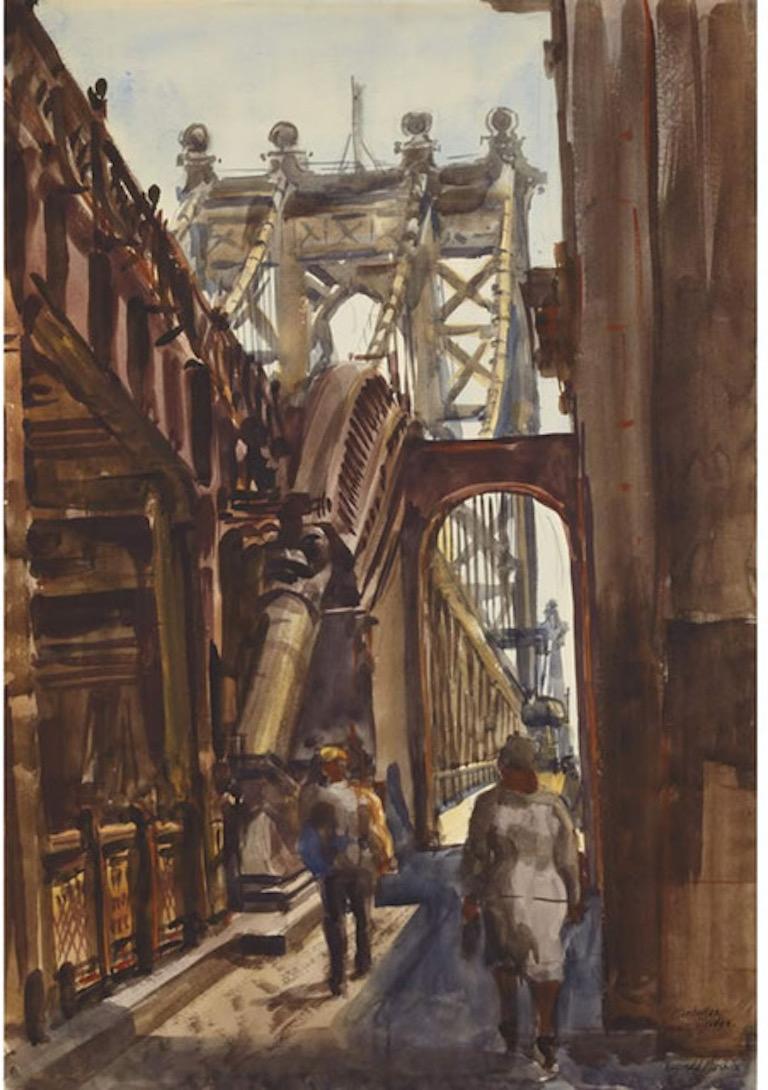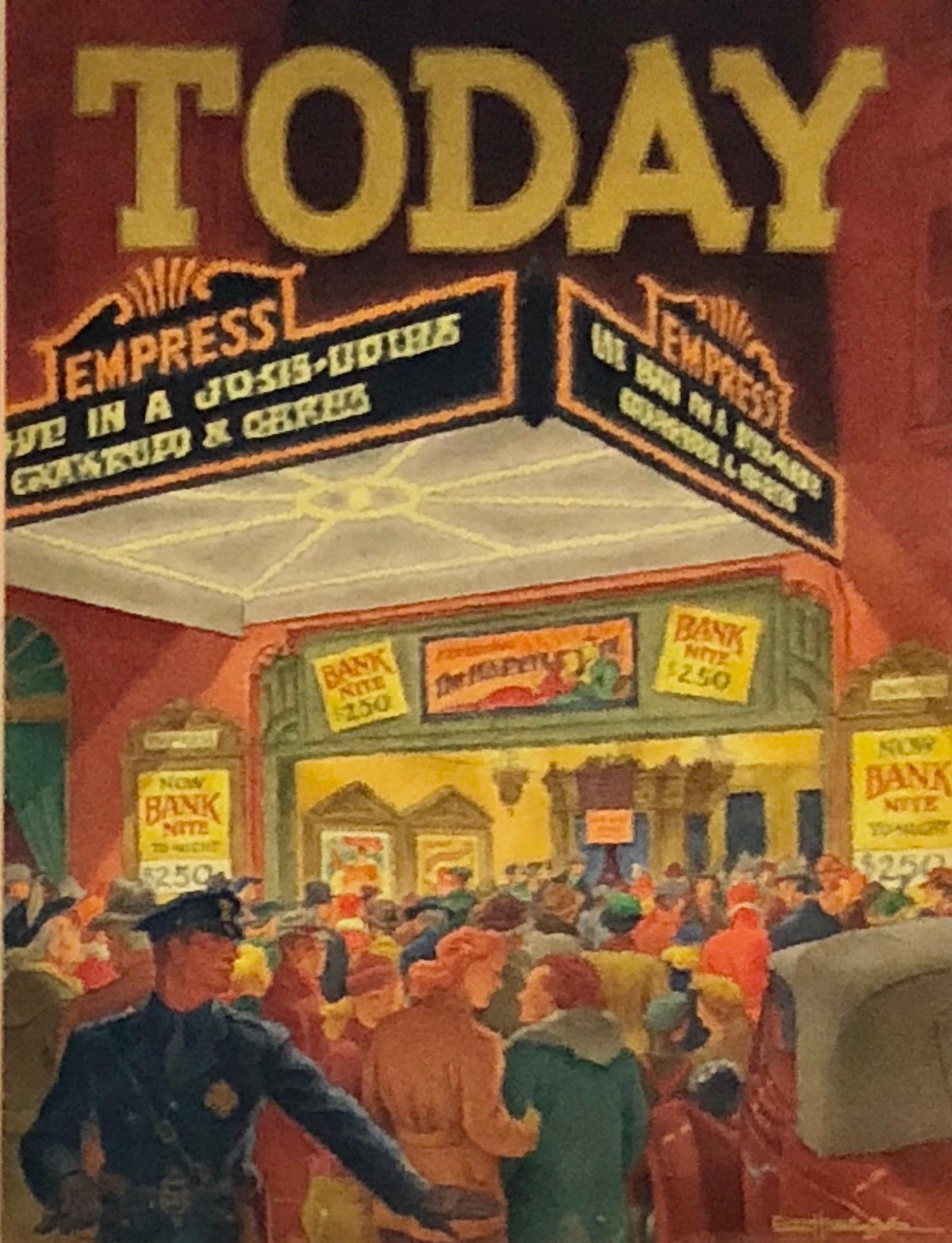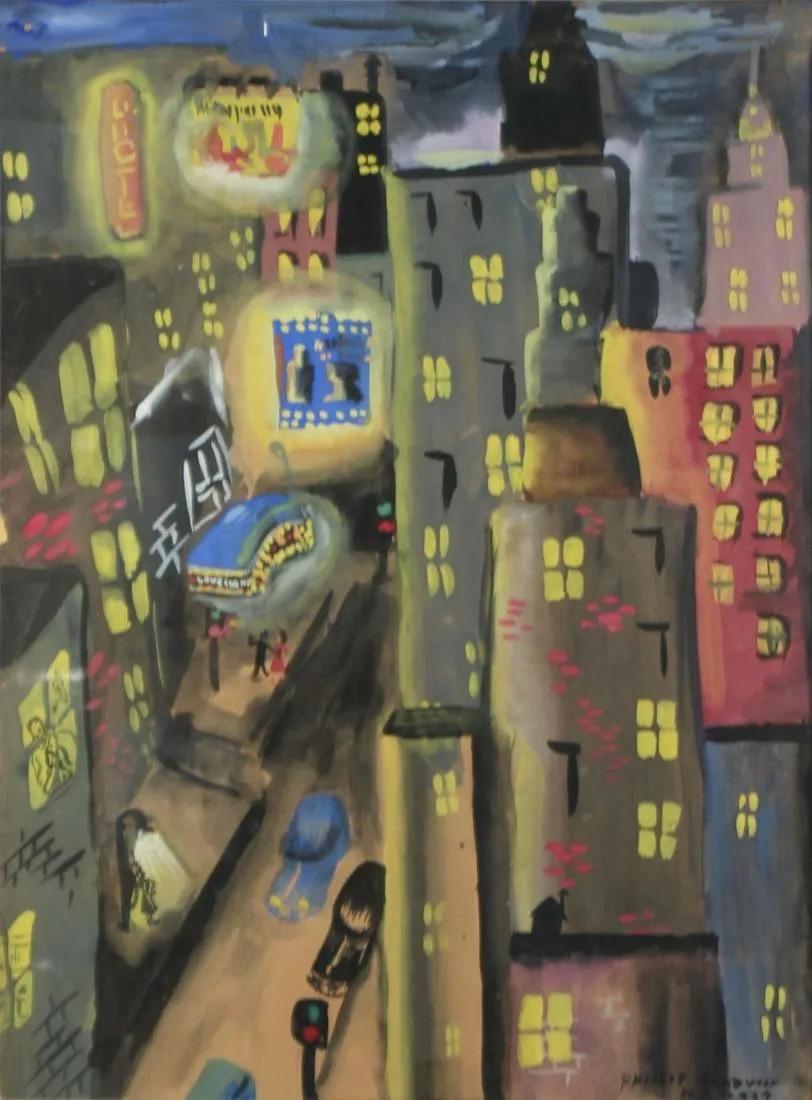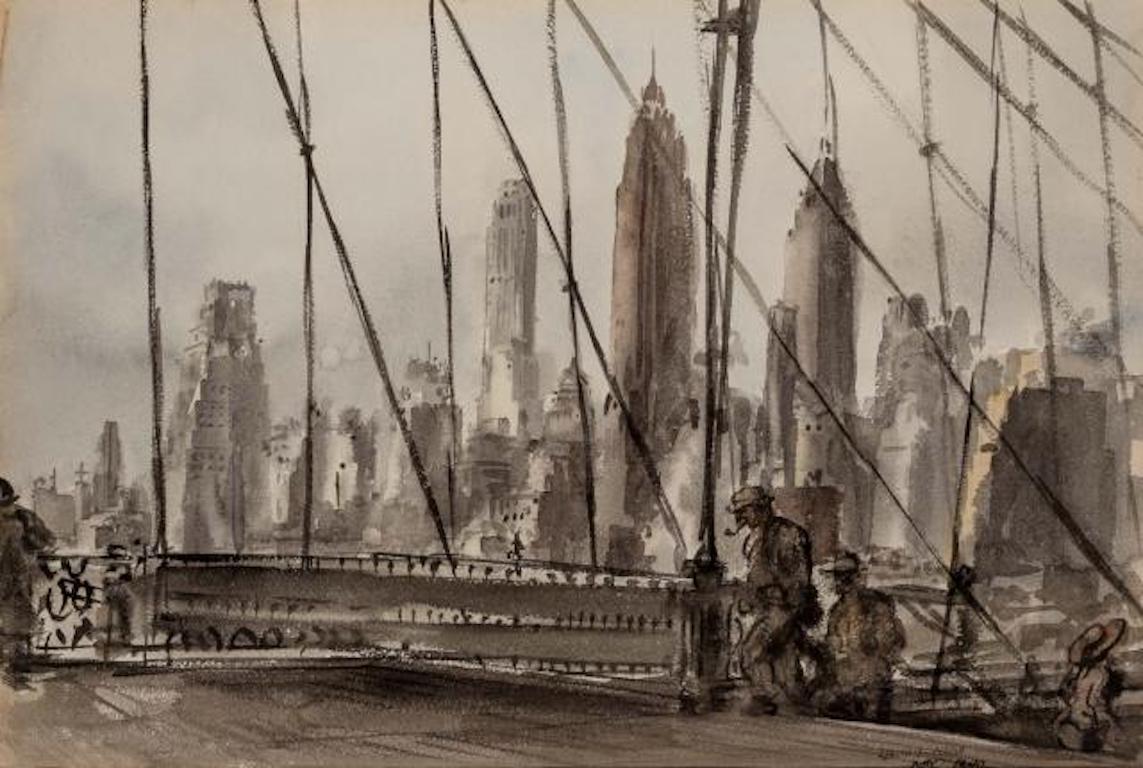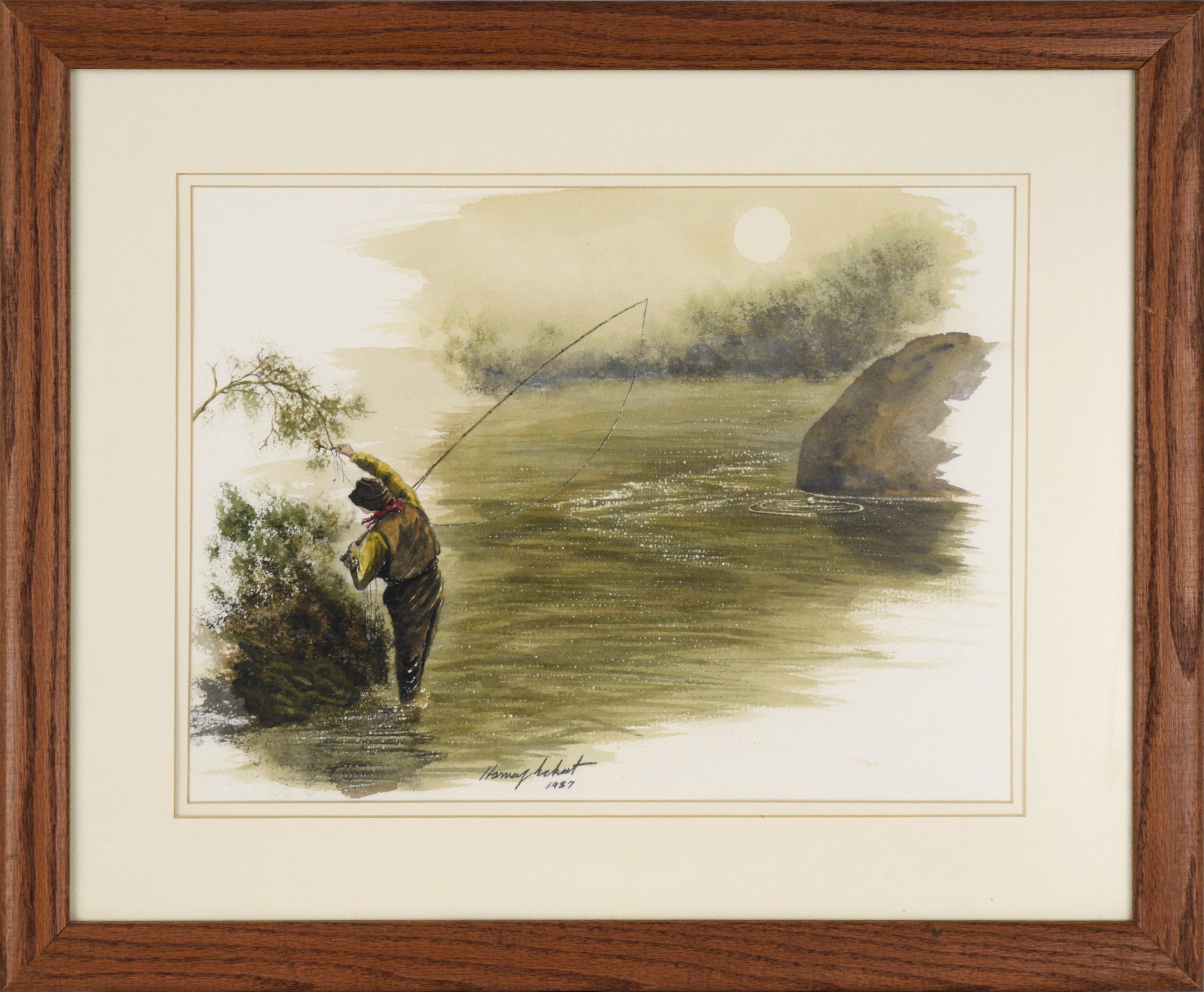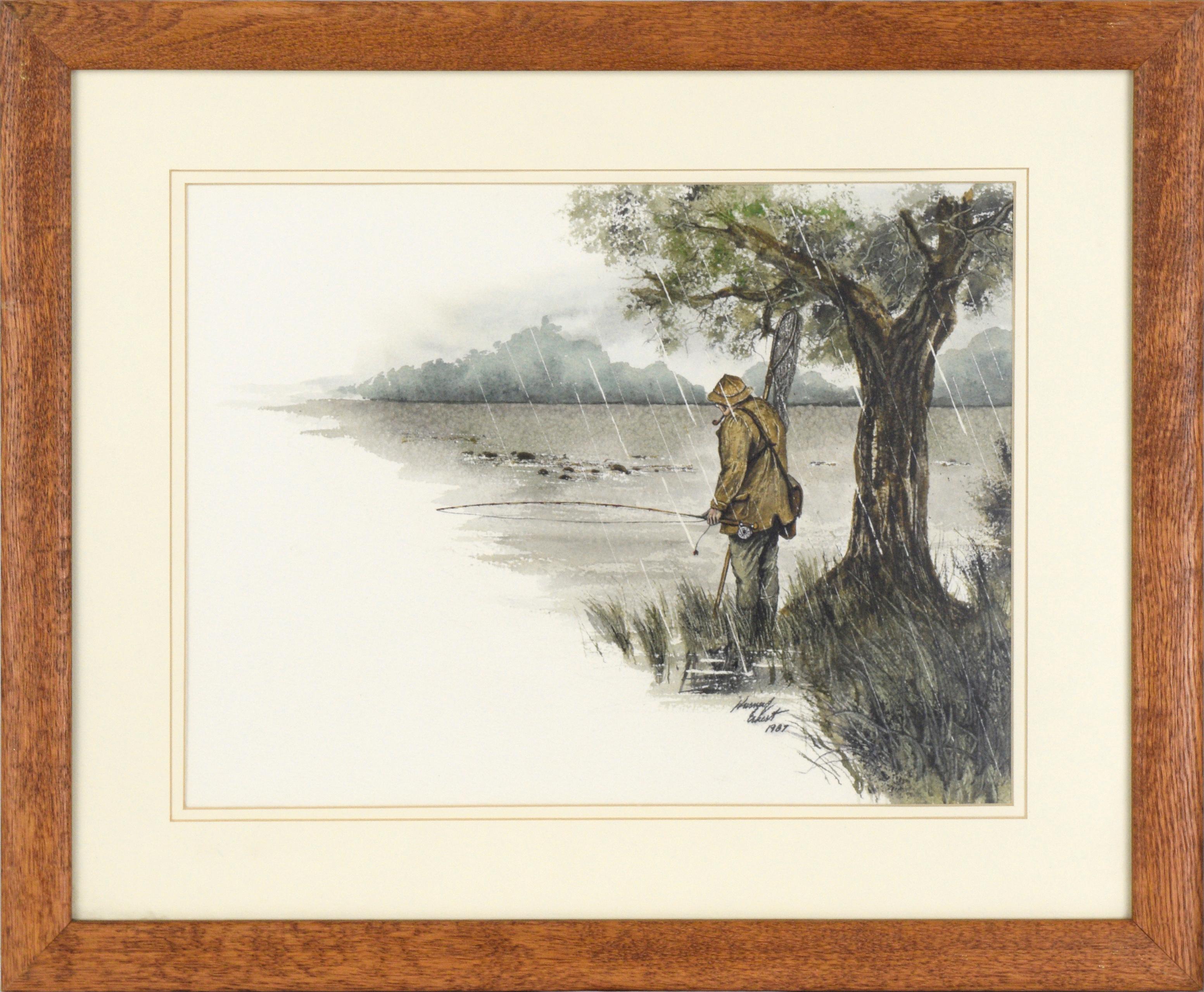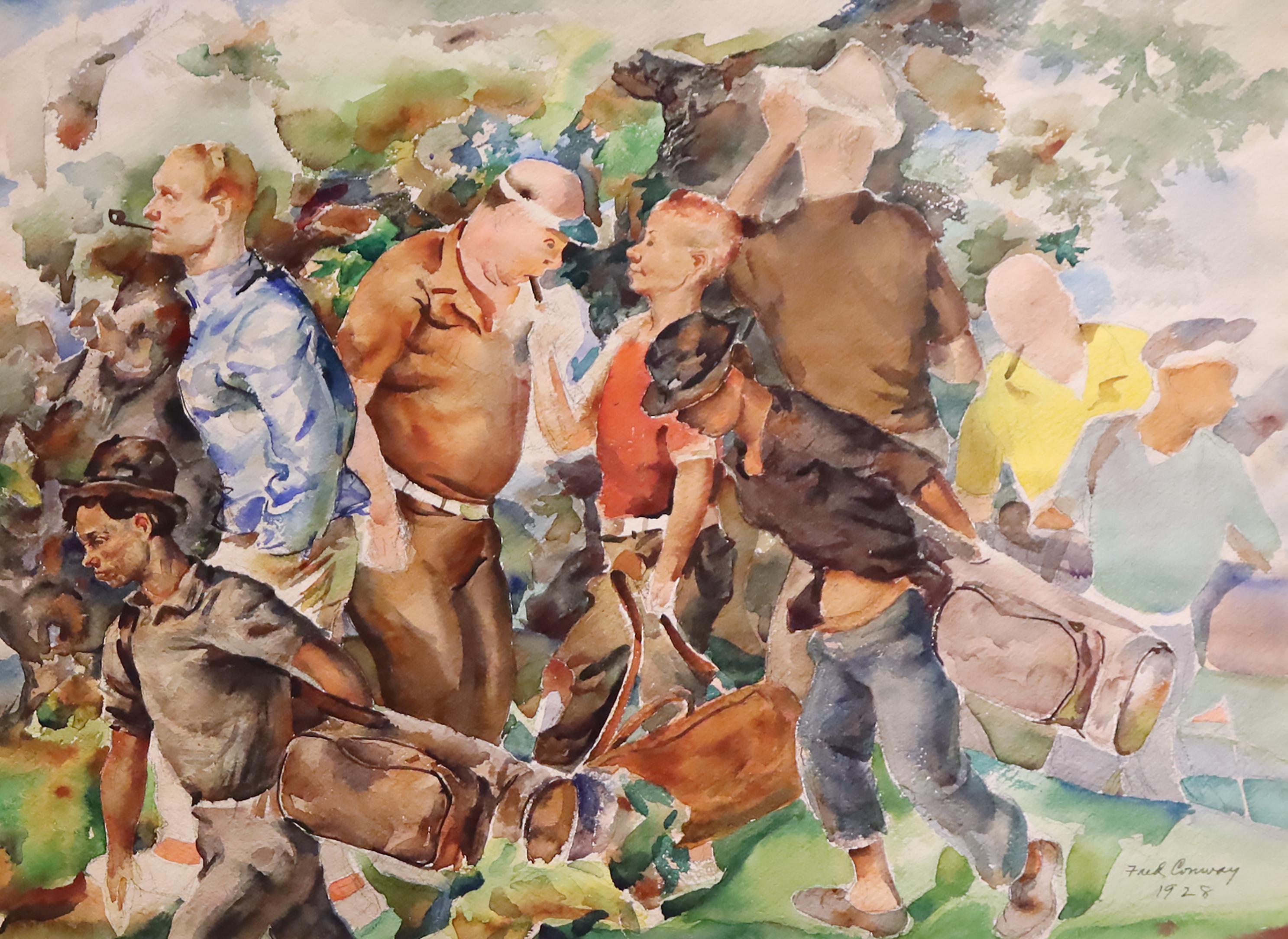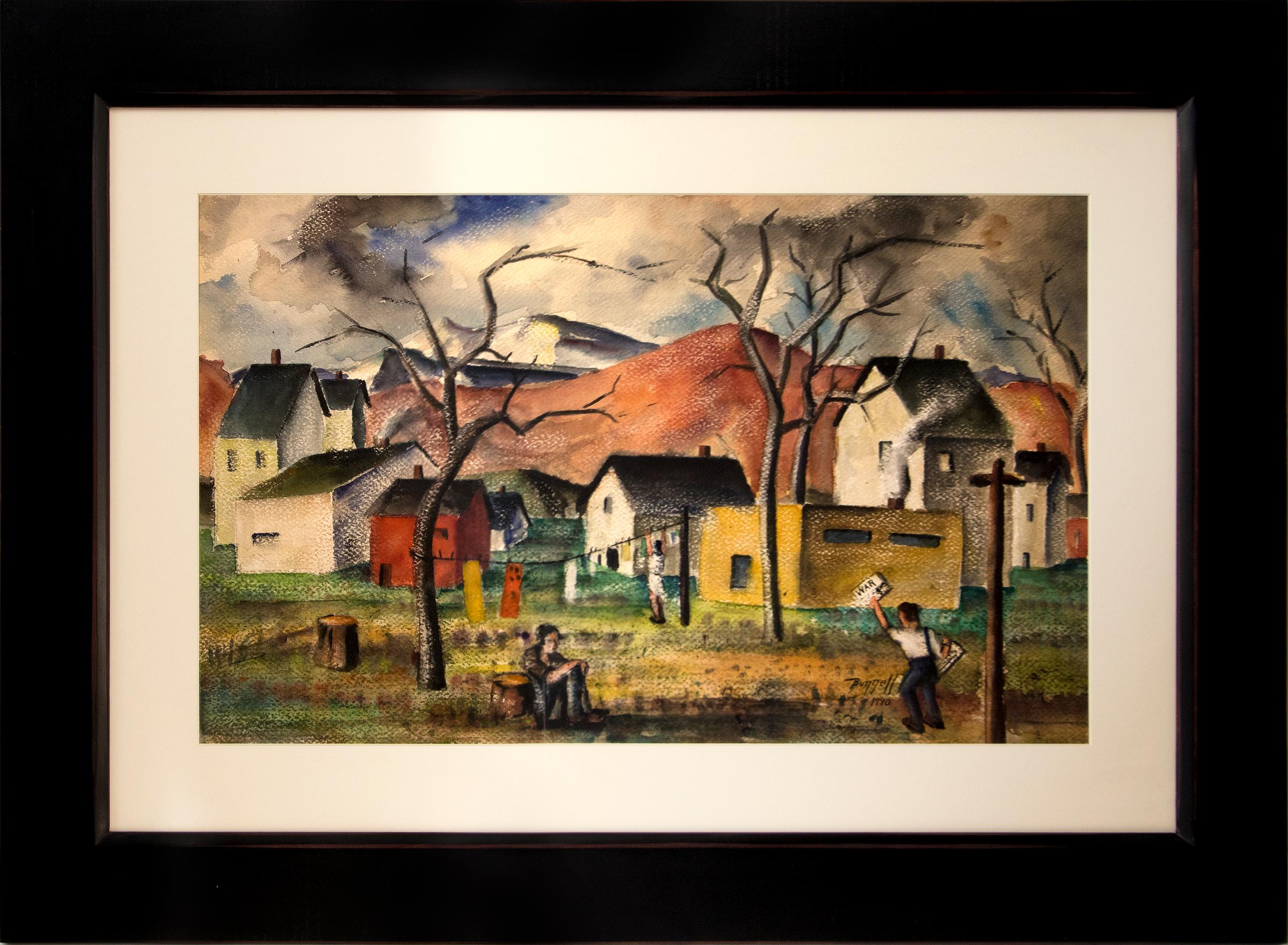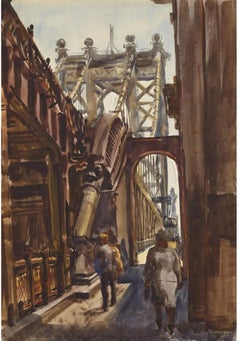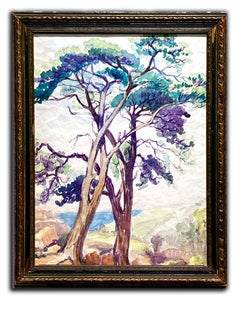
INDUSTRY American Scene Modernism WPA Mural Study Industrial Mid-Century Realism
View Similar Items
Want more images or videos?
Request additional images or videos from the seller
1 of 6
John CostiganINDUSTRY American Scene Modernism WPA Mural Study Industrial Mid-Century Realism1942
1942
About the Item
- Creator:John Costigan (1888 - 1872, American)
- Creation Year:1942
- Dimensions:Height: 44 in (111.76 cm)Width: 30 in (76.2 cm)Depth: 3 in (7.62 cm)
- Medium:
- Movement & Style:
- Period:
- Condition:
- Gallery Location:New York, NY
- Reference Number:1stDibs: LU115626936302
About the Seller
5.0
Platinum Seller
These expertly vetted sellers are 1stDibs' most experienced sellers and are rated highest by our customers.
Established in 2008
1stDibs seller since 2019
164 sales on 1stDibs
More From This SellerView All
- "Manhattan Bridge" NYC American Scene Modernism Watercolor WPA Urban RealismBy Reginald MarshLocated in New York, NYReginald Marsh "Manhattan Bridge" NYC American Scene Modernism Watercolor WPA Urban Realism, 20 x 14 inches. Watercolor and pencil on paper, 1938. Signed...Category
1930s American Modern Landscape Drawings and Watercolors
MaterialsPaper, Watercolor, Pencil
- Magazine Cover Illustration Mid 20th Century Modern Theatre Broadway Realism WPABy Ernest Hamlin BakerLocated in New York, NYMagazine Cover Illustration Mid 20th Century Modern Theatre Broadway Realism WPA Ernest Hamlin Baker (1889 – 1975) “Today Magazine” Cover ...Category
1930s American Modern Figurative Drawings and Watercolors
MaterialsPaper, Ink, Watercolor, Gouache
- "Times Square" Mid 20th Century 1937 Modernism Broadway Drawing NYC CityscapeLocated in New York, NY"Times Square" Mid 20th Century 1937 Modernism Broadway Drawing NYC Cityscape Philip Goodwin (20th Century) "Times Square," 23 ½ x 17 ¼ inches. Gouache...Category
1930s American Modern Landscape Drawings and Watercolors
MaterialsPaper, Gouache
- Reginald Marsh "Brooklyn Bridge" NYC Modernism WPA Mid-Century Watercolor ModernBy Reginald MarshLocated in New York, NYReginald Marsh "Brooklyn Bridge" NYC Modernism WPA Mid-Century Watercolor Modern Reginald Marsh (American, 1898-1954) Brooklyn Bridge, 1940, Signed and dated Reginald Marsh May 1940 (lr), Watercolor over traces of pencil on paper , 15 x 22 inches sight. Reginald Marsh was born in Paris, France in 1898, the child of artist parents. He was born over a small cafe on Paris' Left Bank. He was brought to the United States in 1900 and was drawing before he was three. He studied art at Yale University and the Art Students League, during which time he worked primarily as an illustrator for New York newspapers and magazines. After studying in Paris in 1925 and 1926, he turned seriously to painting. In 1929 he was introduced to the egg-tempera medium, which he used extensively the rest of his life. Marsh's gusto for painting the bottom crust of society contrasted curiously with his background. His parents, both well-known artists, were steeped in academic traditions. He attended Lawrenceville Academy and Yale; perhaps this elite background made it possible to paint the earthy people he did with a journalist's objectivity. An admirer of Rubens and Delacroix, he disliked modernist art; indeed, his lifelong preoccupation was with people - enjoying themselves at beaches, at amusement parks, or on crowded city streets. Marsh was a second-generation Ash Can School painter and printmaker, best known as an urban regionalist. He spent his days sketching in small notebooks...Category
1940s American Modern Figurative Drawings and Watercolors
MaterialsPaper, Watercolor
- "Bathers" American Scene Social Realism 20th Century Modernism Ashcan FauvismBy Charles DemuthLocated in New York, NY"Bathers" American Scene Social Realism 20th Century Modernism Ashcan Fauvism Charles Demuth (1883-1935) "Bathers" 10 1/2 x 8 1/4 inches watercolor on paper, c. 1930 Signed lower le...Category
1930s American Modern Figurative Drawings and Watercolors
MaterialsPaper, Watercolor
Charles Demuth"Bathers" American Scene Social Realism 20th Century Modernism Ashcan Fauvism, c. 1930$88,000 Sale Price20% Off - Industrial Man Working Mid 20th Century American Scene Social Realism Modern WPABy Jo CainLocated in New York, NYIndustrial Man Working Mid 20th Century American Scene Social Realism Modern WPA Jo Cain (1904 - 2003) Hammering Nails 39 x 50 ½ inches Gouache on paper c. 19...Category
1930s American Realist Figurative Drawings and Watercolors
MaterialsPaper, Gouache
You May Also Like
- California Impressionist Landscape Painting Framed 19th Century Rare PurpleLocated in Buffalo, NYAn original American impressionist figurative watercolor of a California coastline with trees.Category
Early 1900s American Modern Landscape Drawings and Watercolors
MaterialsPaper, Watercolor
- Rare Chaim Gross Watercolor Painting Manhattan Skyscrapers Train NYC WPA ArtistBy Chaim GrossLocated in Surfside, FLThis appears to be dated 1927. It came in with a piece dated 1929. A very early, rare work. Framed 22.5 x 18. Image 14.5 x 9 A great New York city street scene with an El train (elevated subway line) and architectural renderings of buildings. This is a wonderful piece by one of America's most treasured artists, Chaim Gross. Throughout his lifetime Gross has gone through tragedy and a real test of faith however, he has the unique ability to focus and direct his expression to the most joyful and beautiful works of art, such as the present lot. For more than sixty years Chaim Gross's art has expressed optimistic, affirming themes. His acrobats, cyclists, and mothers and children convey joyfulness, exuberance, love, and intimacy. This aspect of his work remained consistent with his Hasidic heritage, which teaches that "only in his childlike happiness is man nearest to God." He often used his creative abilities to explore and experiment with media. In his artwork he retains an optimistic philosophy, even when facing somber issues such as war, depression, and the Holocaust. Chaim Gross (March 17, 1904 – May 5, 1991) was an American sculptor and educator. Gross was born to a Jewish family in Austrian Galicia, in the village of Wolowa (now known as Mezhgorye, Ukraine), in the Carpathian Mountains. In 1911, his family moved to Kolomyia (which was annexed into the Ukrainian USSR in 1939 and became part of newly independent Ukraine in 1991). When World War I ended, Gross and brother Avrom-Leib went to Budapest to join their older siblings Sarah and Pinkas. Gross applied to and was accepted by the art academy in Budapest and studied under the painter Béla Uitz, though within a year a new regime under Miklos Horthy took over and attempted to expel all Jews and foreigners from the country. After being deported from Hungary, Gross began art studies at the Kunstgewerbeschule in Vienna, Austria shortly before immigrating to the United States in 1921. Gross's studies continued in the United States at the Beaux-Arts Institute of Design, where he studied with Elie Nadelman and others, and at the Art Students League of New York, with Robert Laurent. He also attended the Educational Alliance Art School, studying under Abbo Ostrowsky, at the same time as Moses Soyer and Peter Blume. In 1926 Gross began teaching at The Educational Alliance, and continued teaching there for the next 50 years. Louise Nevelson was among his students at the Alliance (in 1934), during the time she was transitioning from painting to sculpture. In the late 1920s and early 1930s he exhibited at the Salons of America exhibitions at the Anderson Galleries and, beginning in 1928, at the Whitney Studio Club. In 1929, Gross experimented with printmaking, and created an important group of 15 linocuts and lithographs of landscapes, New York City streets and parks, women in interiors, the circus, and vaudeville. The entire suite is now in the collection of the Philadelphia Museum of Art. Gross returned to the medium of printmaking in the 1960s, and produced approximately 200 works in the medium over the next two decades. In March 1932 Gross had his first solo exhibition at Gallery 144 in New York City. For a short time they represented Gross, as well as his friends Milton Avery, Moses Soyer, Ahron Ben-Shmuel and others. Gross was primarily a practitioner of the direct carving method, with the majority of his work being carved from wood. Other direct carvers in early 20th-century American art include William Zorach, Jose de Creeft, and Robert Laurent. Works by Chaim Gross can be found in major museums and private collections throughout the United States, with substantial holdings (27 sculptures) at the Hirshhorn Museum and Sculpture Garden. A key work from this era, now at the Smithsonian American Art Museum, is the 1932 birds-eye maple Acrobatic Performers, which is also only one and one quarter inch thick. In 1933 Gross joined the government's PWAP (Public Works of Art Project), which transitioned into the WPA (Works Progress Administration), which Gross worked for later in the 1930s. Under these programs Gross taught and demonstrated art, made sculptures that were placed in schools and public colleges, made work for Federal buildings including the Federal Trade Commission Building, and for the France Overseas and Finnish Buildings at the 1939 New York World's Fair. Gross was also recognized during these years with a silver medal at the Exposition universelle de 1937 in Paris, and in 1942, with a purchase prize at the Metropolitan Museum of Art's "Artists for Victory" exhibition for his wood sculpture of famed circus performer Lillian Leitzel. In 1949 Gross sketched Chaim Weizmann, President of Israel, at several functions in New York City where Weizmann was speaking, Gross completed the bust in bronze later that year. Gross returned to Israel for three months in 1951 (the second of many trips there in the postwar years) to paint a series of 40 watercolors of life in various cities. This series was exhibited at the Jewish Museum (Manhattan) in 1953. In the 1950s Gross began to make more bronze sculptures alongside his wood and stone pieces, and in 1957 and 1959 he traveled to Rome to work with famed bronze foundries including the Nicci foundry. At the end of the decade Gross was working primarily in bronze which allowed him to create open forms, large-scale works and of course, multiple casts. Gross's large-scale bronze The Family, donated to New York City in 1991 in honor of Mayor Ed Koch, and installed at the Bleecker Street Park at 11th street, is now a fixture of Greenwich Village. In 1959, a survey of Gross's sculpture in wood, stone, and bronze was featured in the exhibit Four American Expressionists curated by Lloyd Goodrich at the Whitney Museum of American Art, with work by Abraham Rattner, Doris Caesar, and Karl Knaths. In 1976, a selection from Gross's important collection of historic African sculpture, formed since the late 1930s, was exhibited at the Worcester Art Museum in the show The Sculptor's Eye: The African Art Collection of Mr. and Mrs. Chaim Gross. Gross was elected into the National Academy of Design as an Associate member, and became a full Academician in 1981. In 1984, he was inducted into the American Academy of Arts and Letters, with Jacob Lawrence and Lukas Foss. In the fall of 1991, Allen Ginsberg gave an important tribute to Gross at the American Academy of Arts and Letters, which is published in their Proceedings. In 1994, Forum Gallery, which now represents the Chaim Gross estate, held a memorial exhibition featuring a sixty-year survey of Gross's work. Gross was a professor of printmaking and sculpture at both the Educational Alliance and the New School for Social Research in New York City, as well as at the Brooklyn Museum Art School, the MoMA art school, the Art Student's League and the New Art School (which Gross ran briefly with Alexander Dobkin...Category
Mid-20th Century American Modern Figurative Drawings and Watercolors
MaterialsPaper, Watercolor
- Untangling a Fly from the TreeBy Harvey EckertLocated in Soquel, CADelicate depiction of a fly fisherman by Harvey Eckert (American, 1946-2018). Signed in the lower right corner. Presented in a wood frame with a double mat and anti-glare glass. Image size: 14"H x 18"W Harvey Eckert (American, 1946-2018) was an American artist from Kansas. He attended Colby Community College, Hays Emporia State and graduated from Wichita University with two degrees. While living in Montana, he was employed by Bob Wards, Fran Johnson’s Sporting Goods and Cashell Engineers as a surveyor and draftsman. Eckert illustrated three books, Caddisflies by the late Gary LaFontaine, Montana Trout Flies and The Master Fly Weaver by the late George Grant. He did illustrations for the following publications: Montana Outdoors, Colorado Streamside, The River Rat published by Trout Unlimited, Fly Fisherman, Rod and Reel...Category
1980s American Modern Figurative Drawings and Watercolors
MaterialsPaper, Watercolor
- The Fly Fisherman, Figurative Landscape WatercolorBy Harvey EckertLocated in Soquel, CADelicate depiction of a fly fisherman in the rain by Harvey Eckert (American, 1946-2018). This highly detailed landscape watercolor depicts a man fishing in the rain, wading into the water as he smokes a pipe under a tree. Signed and dated in the lower right corner. Presented in a wood frame with a double mat and anti-glare glass. A check from the original purchase is attached to verso (blurred for privacy). Image size: 14"H x 18"W Harvey Eckert (American, 1946-2018) was an American artist from Kansas. He attended Colby Community College, Hays Emporia State and graduated from Wichita University with two degrees. While living in Montana, he was employed by Bob Wards, Fran Johnson’s Sporting Goods and Cashell Engineers as a surveyor and draftsman. Eckert illustrated three books, Caddisflies by the late Gary LaFontaine, Montana Trout Flies and The Master Fly Weaver by the late George Grant. He did illustrations for the following publications: Montana Outdoors, Colorado Streamside, The River Rat published by Trout Unlimited, Fly Fisherman, Rod and Reel...Category
1980s American Modern Figurative Drawings and Watercolors
MaterialsPaper, Watercolor
$460 Sale Price20% Off - GolfersBy Frederick ConwayLocated in Missouri, MOGolfers, 1928 Fred Conway (American, 1900-1973) Signed and Dated Lower Right 18.5 x 24.5 inches 30.5 x 37 inches with frame A member of the faculty of the Washington University Art ...Category
1920s American Modern Figurative Drawings and Watercolors
MaterialsPaper, Watercolor
Price Upon Request - Chinese Theater, Los AngelesBy Dong KingmanLocated in Missouri, MODong Kingman "Chinese Theater, Los Angeles" 1965 Watercolor on Paper Sheet Size: 15 x 22 inches Framed Size: approx 19 x 26 inches Dong Kingman, the world-renowned artist and teacher, died in his sleep on May 12, 2000 at age 89 in his home in Manhattan. The cause was pancreatic cancer. Long acknowledged as an American watercolor master, he has received an extraordinary number of awards and honors throughout his 70-year career in the arts. Included are two Guggenheim fellowships in 1942 and 1943; the San Francisco Art Association First Purchase Prize, 1936; Audubon Artist Medal of Honor, 1946; Philadelphia Watercolor Club Joseph Pennel Memorial Medal, 1950; Metropolitan Museum of Art Award, and the National Academy Design 150th Anniversary Gold Medal Award, 1975. In 1987, the American Watercolor Society awarded Dong Kingman its highest honor, the Dolphin Medal, "for having made outstanding contributions to art especially to that of watercolor." His work is represented in the permanent collections of 50 museums and universities, including the Boston Museum of Fine Arts, M.H. deYoung Memorial Museum of Art, the Metropolitan Museum of Art, the Whitney Museum, Museum of Modern Art, Art Institute of Chicago, Pennsylvania Academy of Fine Arts, Sheldon Memorial Art Gallery and Sculpture Garden, Des Moines Art Center, Columbus Museum of Arts and Crafts, Brooklyn Museum and Hirshhorn Museum. Born in Oakland, California in 1911 of Chinese descent, Kingman moved to Hong Kong at age five. He studied art and calligraphy in his formative years at the Lingnan School. The painting master Szeto Wai had recently studied art in Paris and took a keen interest in young Dongs precocious talents. He taught him both Chinese classical and French Impressionist styles of painting. Kingman returned home to Oakland when he was 18 at the height of the Depression. He worked as a newsboy and dishwasher to make ends meet. When he was employed as a houseboy for the Drew family in San Francisco, he painted every spare moment. In a year, he created enough pictures to have a one-man show at the Art Center. It attracted the attention of San Francisco art critics who raved about Kingmans unique style. Wrote Junius Cravens of the San Francisco News: "That young Chinese artist is showing 20 of the freshest and most satisfying watercolors that have been seen hereabouts in many a day Kingman already has developed that universal quality which may place a sincere artist work above the limitations of either racial characteristics or schools. Kingmans art belongs to the world at large today." Dong Kingman became an overnight success. From 1936 to 1941, he was a project artist for WPA and became a pioneer for a new school of painting, the "California Style." His two Guggenheim fellowships enabled him to travel the country painting American scenes. His first one-man show in New York at Midtown Galleries in 1942 was well received in the media, including Time, Newsweek, the New Yorker and American Artist. M.H. de Young Memorial Museum in San Francisco held a major exhibit of his watercolors in 1945. In 1951, Midtown presented a 10-year retrospective of his work. Time Magazine wrote, "At age 40, Kingman is one of the worlds best watercolorists." Other retrospectives, including Corcoran in Washington,D.C. an d Witte Memorial Museum in San Antonio, were held for the artist. Kingman moved to Wildenstein (1958-1969) where he had successful exhibits in New York, London and Paris. Hammer Galleries exhibited his paintings in the 70s, and then the artist expanded his venues to the West Coast and Far East. During World War II, he served with the OSS in Washington, D.C. where he was a cartographer. After his honorable discharge, Kingman moved to Brooklyn Heights from San Francisco when he became a guest lecturer and then art instructor at Columbia University (1946-1958). Hunter College also appointed him instructor in watercolors and Chinese Art (1948-1953). His teaching career continued with the Famous Artists School, Westport, CT in 1953, joining such distinguished artists on the faculty as Will Barnet, Stuart Davis, Norman Rockwell and Ben Shahn. He also became a teaching member for 40 years for the Hewitt Painting Workshops, which conducts worldwide painting tours. He taught at the Academy of Art College in San Francisco, was a member of its board, and received an honorary doctorate from the Academy. In 1954, the U.S. Department of State invited Kingman to go on a cultural exchange program tour around the world to give exhibitions and lectures and to meet local artists. When he came home, he presented the State Department with a 40-foot long report on a scroll, which later appeared in LIFE Magazine. One of Kingman's most treasured experiences was his invitation by the Ministry of Culture of the Peoples Republic of China to exhibit in that country in 1981. He was the first American artist to be accorded a one-man show since diplomatic relations resumed. More than 100,000 visitors attended his exhibitions in Beijing, Hangzhou and Guangzhou and the retrospective received critical acclaim from the Chinese press. Noted the China Daily Mail, "Just as the master painters of the Song Dynasty roamed about mountain and stream to capture the rhythm of nature, Dong Kingman traveled the world capturing the dynamism of modern lifefamiliar scenes have been transformed into a vibrant new vision of life through color schemes with rhythms that play over the entire surface of the picture. The wind swept skies which enliven his watercolors remind us of the pleinairism of the French Impressionists." Kingman, who has been fascinated with movies since seeing his first film "The Thief of Baghdad...Category
1960s American Modern Landscape Drawings and Watercolors
MaterialsPaper, Watercolor
Price Upon Request
Recently Viewed
View AllMore Ways To Browse
Farm Style Islands
Vintage Farm Signs
Vintage Farm Paintings
Vintage Livestock
Lehman Brothers
Industrial 1940 Wpa Painting
Wpa Market
Vintage Farm Animals
Vintage Pastoral Paintings
Vintage Rosenfeld
Costigan Watercolor
Vintage Carousel Drawing
Helen Vogt
Emmy Lou Packard
Walt Disney Fantasia
Chairs Reeves
Bett Vintage
Journal Des Dames Et Des Modes
